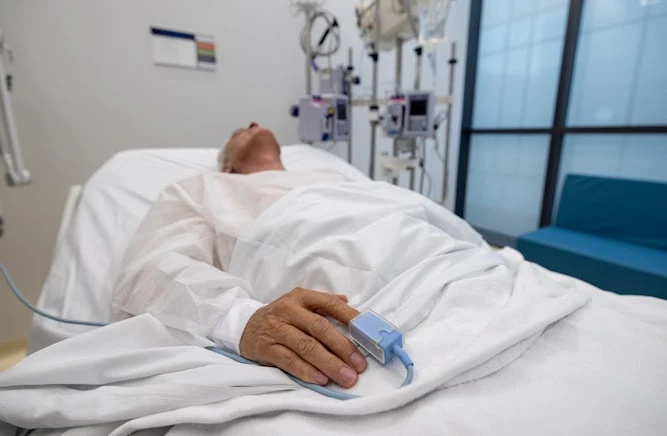Traumatic brain injury (TBI) is a highly prevalent global health issue, causing significant mortality and disability. It results from external forces affecting brain function or structure. TBI involves primary damage from the initial impact, followed by secondary injury processes such as ischaemia, swelling, and metabolic changes, which worsen outcomes if not managed promptly.
Immediate treatment focuses on reducing intracranial pressure (ICP) and preventing systemic complications like hypoxia and hypotension. Fever in TBI patients can exacerbate secondary injuries and is linked to poorer clinical outcomes, including increased mortality.
Targeted temperature control (TTC) strategies, ranging from fever prevention to induced hypothermia, are utilised in neuro-intensive care to mitigate these risks and improve neurological recovery. However, optimal TTC practices for TBI remain uncertain.
Two systematic reviews, one covering literature from 2013 onwards and another specifically focusing on RCTs, informed the statements and questions discussed. The reviews highlighted a lack of sufficient RCTs and significant clinical variability among existing studies, making meta-analysis impractical.
This consensus review aimed to assess current evidence on TTC in severe TBI within critical care settings and to formulate practical recommendations addressing gaps in existing literature. The review emphasises the reliance on expert opinion to guide practice due to the absence of definitive methods for delivering high-quality TTC.
Temperature management is crucial in severe TBI due to its impact on secondary brain injury risks, especially in patients at high risk of cerebral herniation. Compared with less reliable superficial temperature measurements, core temperature monitoring, preferably through the bladder or oesophageal probes, was deemed essential for accurate assessment and treatment guidance. Continuous temperature monitoring was strongly favoured over intermittent methods to avoid missing critical fluctuations. Brain temperature monitoring, while promising, requires further research for practical clinical application.
In ICP management, temperature control plays a vital role, with controlled normothermia recommended alongside tiered treatments according to the Seattle International Severe Traumatic Brain Injury Consensus Conference guidelines. Therapeutic hypothermia may be considered if tiered treatments fail, with careful temperature management to mitigate adverse effects. The group discussion underscored the lack of consensus on using therapeutic hypothermia as a rapid intervention in severe TBI cases with impending cerebral herniation or before neurosurgical interventions like hematoma evacuation or decompression. While acknowledging the potential effectiveness in reducing ICP, uncertainties around rapid induction and insufficient evidence prevented clear recommendations. There was divergence on the lowest target temperature, with 35.0 °C being a common suggestion, yet no consensus was reached. Variability in centre-specific capabilities, including access to neurosurgical interventions, influenced clinical preferences for hypothermia as a temporary treatment option.
Regarding fever management, the group emphasised the need for prompt detection and treatment of neurogenic fever (core temperature > 37.5 °C), irrespective of ICP levels, to mitigate secondary brain injury risks in severe TBI patients. Controlled normothermia was recommended in cases where fever was secondary to sepsis or inflammatory processes, highlighting the importance of temperature management regardless of its origin. The group also discussed the challenges in distinguishing between central fever and infection-related fever, emphasising the critical need for accurate temperature control to prevent neurological complications.
Automated feedback-controlled devices for TTC were endorsed for their precision in maintaining optimal temperature ranges and minimising fluctuations, particularly during the induction and maintenance phases. The group supported using these devices for effective TTC management, acknowledging their role in improving patient outcomes and reducing the risk of adverse events such as rebound hyperthermia. Recommendations included continuous monitoring and careful management during the rewarming phase to prevent abrupt temperature shifts that could negatively impact neurological recovery.
Shivering management in TBI patients was highlighted as crucial due to its potential to compromise cerebral oxygenation and negate the benefits of TTC. Strategies included titrating sedation and considering neuromuscular blockers when necessary, particularly in patients with labile ICP. The group also recognised the importance of individualised risk-benefit assessments in deciding between controlled normothermia and permissive hyperthermia, particularly in less critically ill patients.
Metrics such as "time within target range" and "burden of fever" were identified as useful indicators for auditing quality temperature management in TBI care. However, the group acknowledged the variability in clinical practices and resources across centres, emphasising the need for flexible auditing approaches that can accommodate different monitoring capabilities and patient populations.
TTC is recognised as a therapeutic intervention in managing ICP and potentially mitigating secondary injury, thereby improving long-term neurological outcomes in TBI patients. However, methods for implementing TTC vary widely across clinical settings and patient populations, and robust evidence supporting its consistent application is lacking. Despite these challenges, the consensus from the Delphi process affirms that TTC is integral to high-quality TBI care.
Source: Critical Care
Image Credit: iStock








